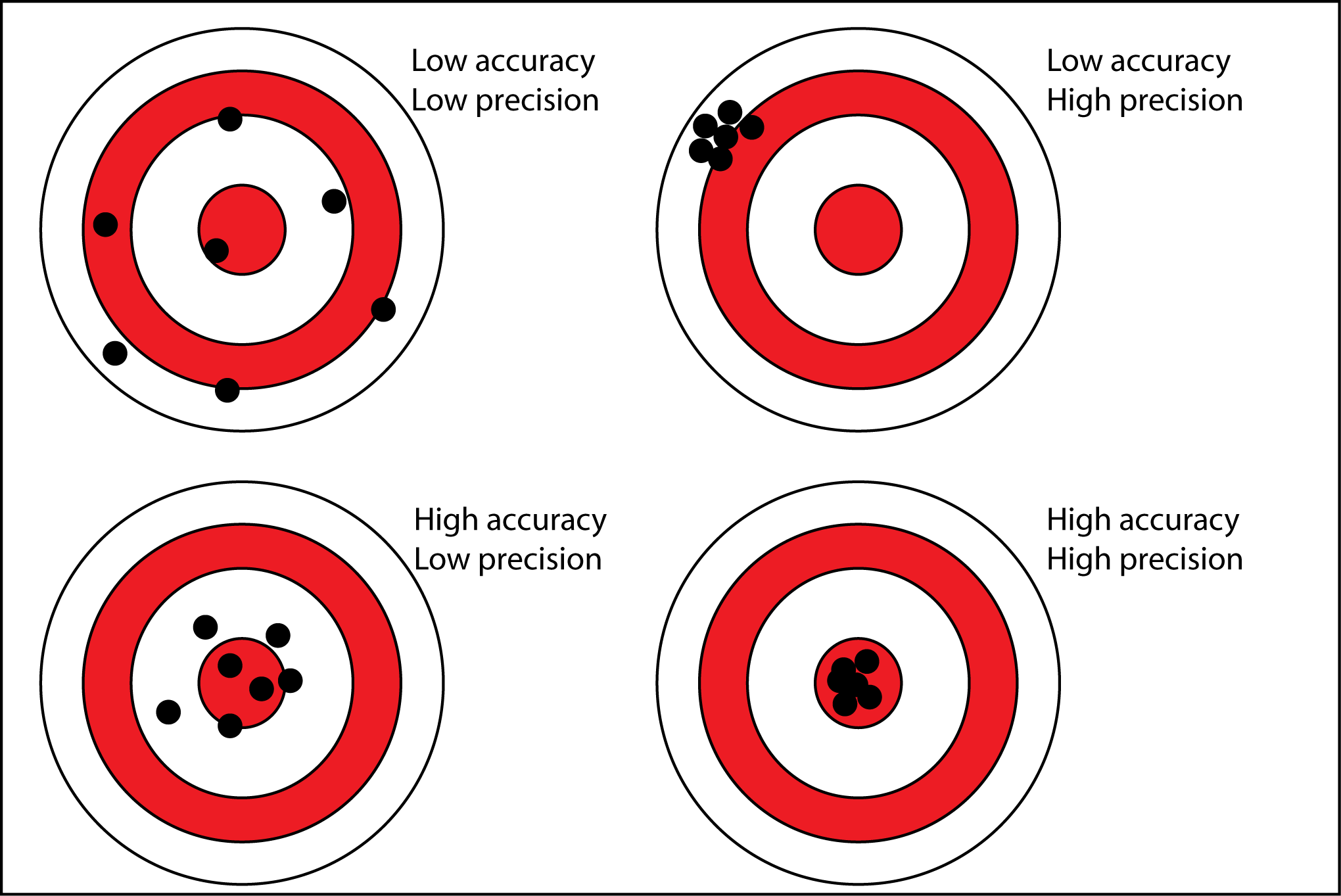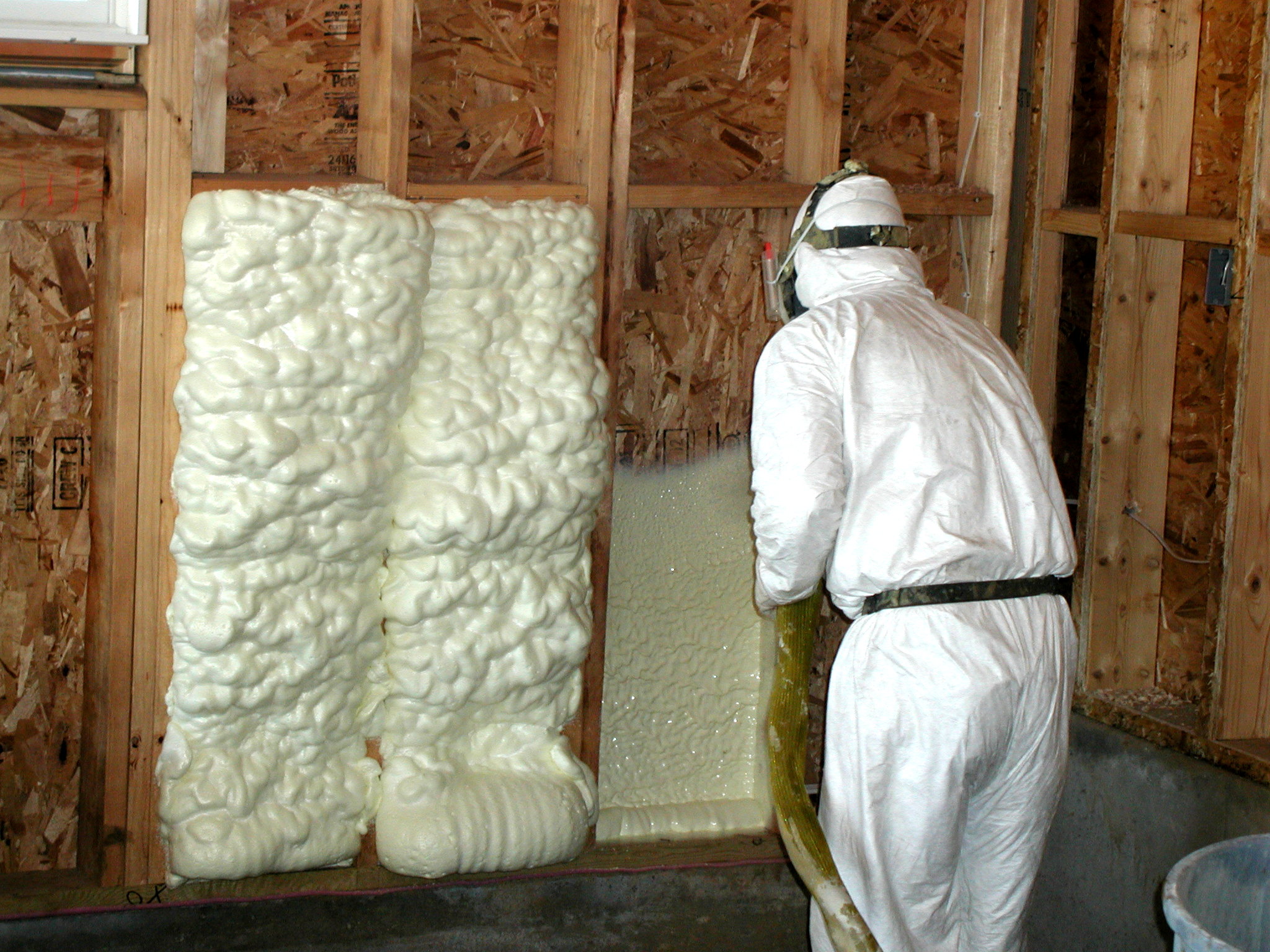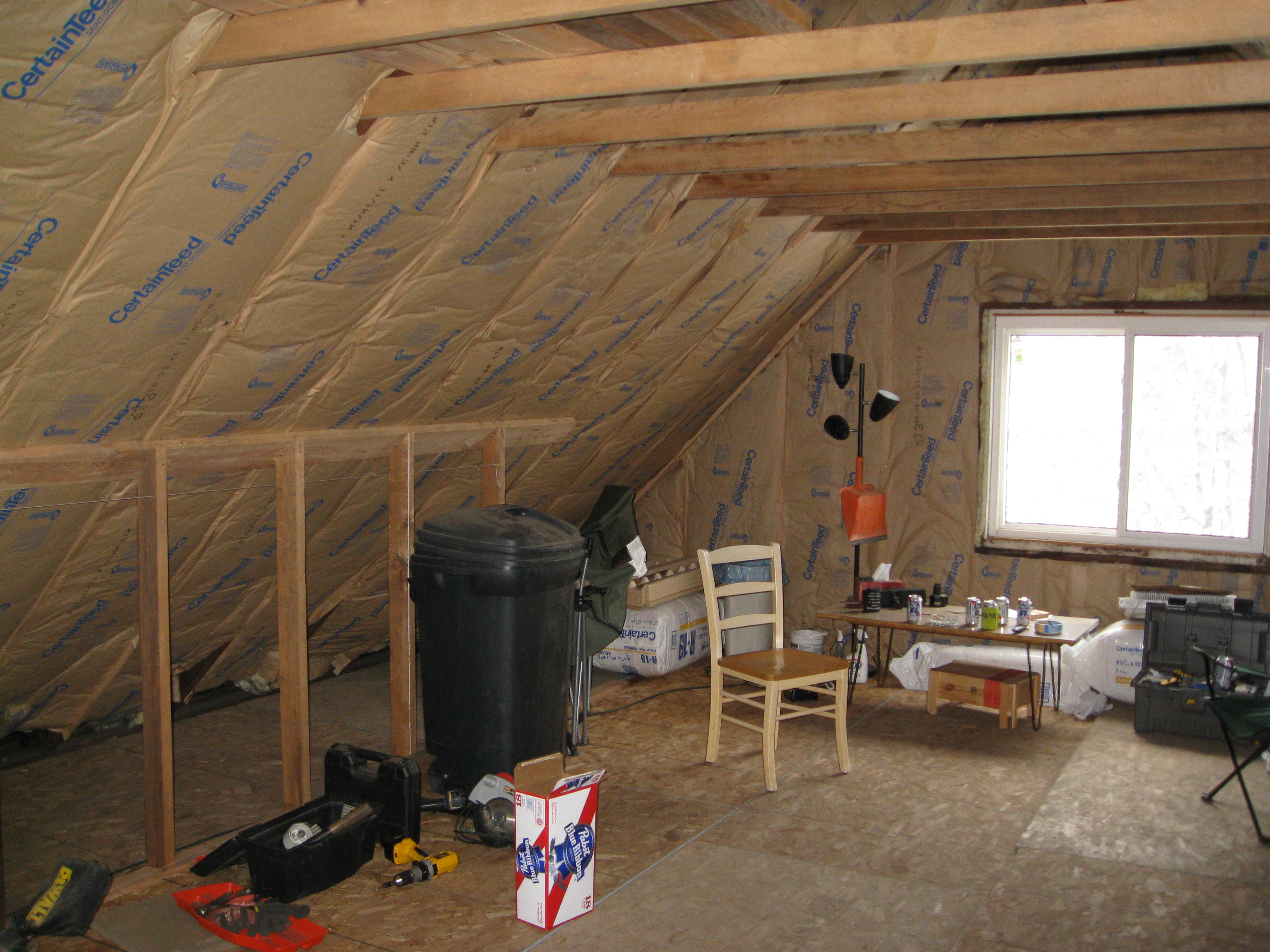One Knob Part 4 – Program Description
Has your experience working within or for an Energy Efficiency Program (program) felt like the above picture? Did you feel the correct and smart path continuously departed from the paved path?
Having many colleagues on the program and contractor sides, it’s pretty clear that programs, as they stand today, fail. Let’s do better. Better for homeowners, better for contractors, and better for programs too! The One Knob program design is an attempt to pave a path where people want to walk.
In part 1 we talked about how a good program should have 3 goals: Results Focus, Accountability, and Market Transformation.
In part 2 we examined how Low Hanging Fruit thinking is an impediment to good design when it comes to Home Performance. This thinking is a big factor behind the dismal realization rates of Energy Efficiency Programs (programs). We also shared how bigger, more comprehensive jobs have a higher likelihood of good results because they gain better control of heat, air, and moisture flows. Bigger jobs are better for homeowners, contractors, and programs interested in energy reduction.
In part 3 we touched on some hard truths of Home Performance that are holding our industry back from scaling. Markets cannot be administered into existence. Capitalism doesn’t work that way. Trust and confidence in positive outcomes where the benefits are greater than the effort is critical for scale. Currently there is no confidence in Home Performance Programs delivering results.
So without further ado, here are the Key Aspects to One Knob:
- One Knob = Negawatt – One simple adjustment. One easily interpreted market signal. No management from above, no program tweaks, just adjust the volume of Negawatt incentive. Just pay for saved energy in negative watts, or Negawatts. Raise and lower as needed, just like the volume knob in your car.
- Results Focus – Excellence, accuracy, and savings are all incentivized, which means they are likely to occur. These do not truly exist now, except via false proxies. One Knob delivers desired results.
- Pay for Projected Savings – If 10,000 kilowatt hours are projected to be saved, and the rebate is $.40 per kwh saved, the homeowner gets a check for $4000. Convert savings from all fuels to kilowatt hours, meaning Negawatts.
- Rebate Process – Project completes; homeowner rebate is paid; once per year contractor ratings are updated and published. Updates could be continuous with the Energy Savvy platform.
- Accountability/Reward – Contractors have the most control over results. So let them make the projections. Let them choose the software. Let them choose measures. It makes kitchen table transactions much simpler.
- Publish contractor metrics and rank them. – HPXML will collect the needed data, and the industry is moving that way. Promote the rankings so contractors can use them to build trust and confidence at the kitchen table. Excellence becomes its own reward and failure a public badge of incompetence. Data is critical.
- Build Intellectual Capital – By giving contractors authority for design and accountability for results, you create an intensely competitive environment where huge gains in workforce talent occur.
- Leverage Desire for Better Homes – Homeowners will make large investments to fix problems. Good incentive design can harvest energy savings from these improvements at the savings value. One Knob’s simplicity allows and encourages scale. Focus on comfort, health, and safety messages, not energy savings.
- Win-Win-Win – Homeowners get problems solved, contractors make a living, and the other parties get the cost effective energy savings they need (without puffery). One Knob aligns interests.
- Not Punitive – Humans react far better to positive reinforcement. Multiple ranking metrics can be promoted – good air sealing, good realization rates, highest energy savings, best energy savings per dollar spent, etc. Everyone is likely to have something good to point at. Still, no one wants to rank on the bottom, it’s an incentive to do well.
- Breeds Mutual Respect- Contractors are not treated like children, as is often the case now. All parties act as equal partners working towards common goals.
- Fuel Agnostic – Small changes crush contractors, they need ONE track to follow. No crazy rules about fuel switching, or different “incentives” for different fuels like electricity, propane, or natural gas. Just pay for energy savings in Negawatts. An ‘energy bank’ could create a buffer to perversity introduced by funding sources.
- Nothing New Needed – Except accountability and a transparent results ranking system. Today’s contractors, employees, software, equipment, etc. will all work with One Knob.
- Future Financing – Financial markets need some certainty of savings showing up to offer low rates. One Knob will provide this data and ever improving certainty. One Knob rewards accuracy and precision in a space where accuracy and precision have never been an objective. Market Transformation is far easier once low cost financing that stays with the house, i.e. On Bill Financing, is available.
- Align Interests and Incentives – Homeowners, contractors, programs, utilities, and PUCs all have different objectives but can be pulling in the same direction. One Knob achieves this. No perverse incentives.
- Substantially Less Administration – If Market Transformation is to occur there is no way current administration can scale with it. High ranked contractors will get automatic job approval (remember, their results will still be ranked, so they still can’t skimp) leading to less admin for both contactractor and program. One Knob is scaleable, and more effectively puts ratepayer funds back in ratepayer hands.
So, What Are You Thinking?
If you are feeling a ton of objections, that’s normal. Remember in part one where your reaction to new ideas was gauged, and if you are a ‘no,no, NO!’ person I asked you to move on? This is why. The One Knob idea is new, and questions are normal.
Here are a few common questions:
1. Isn’t paying for the Negawatt too simple?
2. Won’t contractors attempt to cheat the system?
3. Why will anyone use the registry? Will consumers see it?
4. Aren’t accuracy and precision impossible for Home Performance?
5. How can a program be fuel agnostic?
1. Isn’t paying for the Negawatt too simple?
What is it that programs, utilities, and public utility commissions (PUCs) want? Energy savings to meet their goals. Incentivizing saved energy directly is the fastest and simplest path there.
Why the heck do we create these wildly complicated structures of Simon Says and Mother May I to deliver those savings, and then fail at it? Most programs have 30-70% realization rates. In manufacturing, Six Sigma requires 3.4 failures or less in 1 million.
Programs fail to deliver pretty much every time; for profit businesses would be in lawsuits and out of business with these results. It’s clear something isn’t working.
Peter Drucker says ‘What’s measured gets managed.’ So why not incentivize and measure the actual energy savings by paying for actual energy savings, or Negawatts? (A Negawatt, by the way, is a term coined by Amory Lovins that means saved energy, or negative watts.)
Of all the parties involved in an efficiency upgrade, who has the most control of final results? The contractor, of course. The contractor should be incentivized to save energy. The contractor also has responsibility to solve the problems the homeowner called them for. Where does all of this need to happen? The kitchen table. Right now continuously shifting program rules make this transaction onerous. Why not give contractors the power to predict energy savings and determine the Negawatt incentive?
This will result in bigger jobs that save more energy more accurately and more precisely, for much less public cost. Where current programs spend $1-4 per Negawatt, this would work really well at 50 cents.
Keep complexity out. This is critical. Programs can no longer make monthly or weekly adjustments to program, complicating kitchen table transactions. At 50 cents the program is a junior partner and needs to behave as such. Fuel agnostic (everything converts to KWH), improvement agnostic, software agnostic, be sure to avoid influencing the “how” or failure and blame will rightfully continue to fall on programs.
2. Won’t contractors attempt to cheat the system?
First – appeal to adverse consequences fallacy – this question implies they AREN’T cheating the system now. The question should be “will less cheating occur?” and the answer is a resounding yes! By removing reasons for cheating, cheating will diminish.
The first year will be a bit wild while everyone figures out how to achieve accuracy, but it will be like being Freshmen in High School – everybody will be lost together, and by Sophomore year everyone will know their way around.
With proper design and published results, contractors project savings first and then are rewarded based on how accurate they were. This means contractors will be incentivized to be as accurate as possible. If they overstate savings purposely, they will pay a price when their accuracy ranking drops, just as car companies pay a price when their JD Power rankings drop. Cheating is counterproductive, overstating savings means a lower accuracy ranking and other potential penalties (more rigid job approval process, etc..). So the risk of contractor cheating to get consumers a few additional dollars incentive is quite low.
Currently, programs attempt to manage this risk themselves through rules. Unfortunately, they end up artificially limiting job sizes, a result of chasing low hanging fruit, as discussed in part two.
Paying incentives one year after the job after actual energy savings are determined is absurd. Homeowners are unlikely to move forward with that much uncertainty, it will not serve as an incentive at all. Incentives need to be paid up front with the job. Paying for contractor energy predictions is the simplest way to pay incentives up front. Homeowners will never have rebates taken back from them, but contractors that consistently overestimate savings will drop in accuracy rankings. If a contractor has a 90% realization rate, that might be the best that year, others may have 50% realization rates from overestimating savings and be ranked lower. Lower rankings will cause jobs to be challenged more by programs, slowing the sales process. Higher rankings will eventually lead to automatic job approval. So there are multiple reasons to play it straight.
Accountability Is the Answer – It Focuses on Results
The solution is simple: publish results in a registry. If a contractor wildly overstates predicted savings, it will push them down the rankings and make it harder to sell projects next year. The focus stays on the results: solving client problems and saving energy. We have found that well designed projects solve homeowner problems AND save substantial amounts of energy, so all parties get what they want.
3. Why will anyone use the registry? Will consumers see it?
Rankings are a marketing tool. Even if consumers don’t know about the registry, high performing contractors will tell clients about their rankings. “Oh look, we can show this at the kitchen table.”
If you are an Angie’s List Super Service Award recipient, or a Century Club contractor, are you likely to say something about it? Of course. So if you ranked #1, or even #4 in the region for predicted energy savings results, would you be likely to bring that up when you find out you’re bidding against #20? And would #20 want to go higher the next year?
JD Power rankings are sought after by consumers and automakers alike. Not long ago the industry was poorly measured, and made poor products. JD Power elevated Honda and Toyota, nearly bankrupting the Big 3. Today cars are of far higher quality, and manufacturers brag about their rankings. Isn’t the same thing likely in Home Performance?
4. Aren’t accuracy and precision impossible for Home Performance?
How would we know when they’ve never been an objective? If you don’t track AND reward accuracy and precision why would you expect it to exist? Furthermore, there are indications both in academia and in the wild that when you are TRULY comprehensive, high levels of accuracy and precision are possible.
Danny Parker of the Florida Energy Center, Rick Chitwood of Chitwood Energy, and Mike MacFarland of Energy Docs in Redding CA all have tantalizing evidence that Home Energy Saving is not hocus pocus.
Parker analyzed a ton of data from Home Energy Saver and found that slightly deeper ‘Operational’ energy audits that included a thorough homeowner interview were accurate within about 1.5% on actual usage, where even a standard energy audit (Asset::Full) was still off substantially. (See 32:30 in this video.)
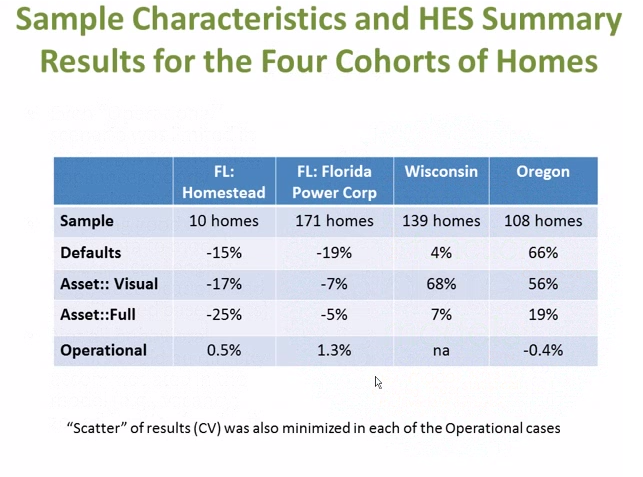
Rick Chitwood did a study that showed when you do truly comprehensive home performance the results actually exceed expectations. A surprising result is the stellar reduction in Peak Energy Demand.
MacFarland guarantees energy use in client homes. Mike can predict energy bills to a few bucks a month, which he then guarantees. He tracks so tightly that when a client buys a plasma TV, it throws his results off and he sees it.
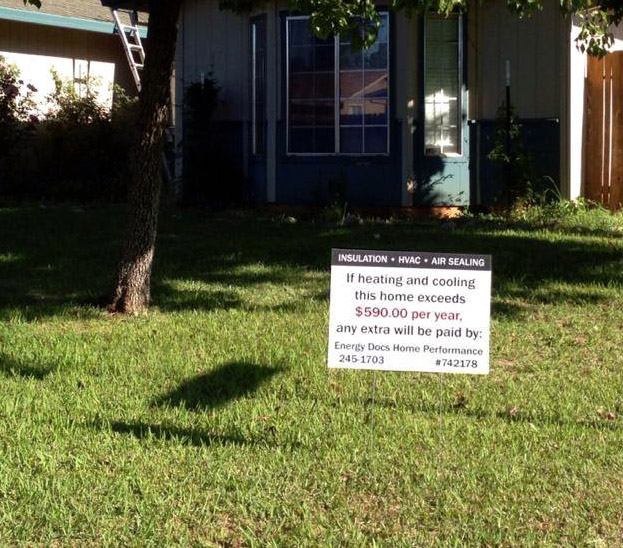
Parker found through analysis of Home Energy Saver data that consumption is very predictable, Chitwood found that more comprehensive jobs result in surprising societal benefits, and MacFarland is confident enough in his work he guarantees crazy low energy usage, does this make them Da Vinci, Galileo and Columbus?
As discussed in part 2 about Low Hanging Fruit, significant energy savings are not likely to occur until adequate control over heat, air, and moisture flows in a home is achieved. Until then large variations in results are likely. This lines up with Chitwood and MacFarland’s experience as well.
Accuracy and precision CAN be had in Home Performance, we need to incentivize larger jobs that get us to the point where results are likely. HVAC upgrades and building enclosure upgrades need to be planned for, and preferably happen, simultaneously. I am not the only one to argue for simultaneous instead of staged upgrades, Dan Kartzman of PowerSmith does a great job here.
5. How can a program be fuel agnostic?
In order for One Knob to work, it must be fuel agnostic. Designers must stay client focused. The client is NOT the program, it’s the homeowner. Designers must develop a practice that focuses on best results for the client and not be enticed away by changing incentives. There is mounting evidence in NY that fuel bias has significantly harmed homeowners who participated in the program by shifting them from electric to propane instead of to heat pumps. (Heat pumps are not “an approved measure.”) In California if a client switches from gas and electric to electric only they likely don’t qualify for a number of rebates.
It’s vitally important that programs using One Knob are completely agnostic to methods, materials, and fuels so that Energy Efficiency remains a primary objective. The only thing that matters is results.
Programs often have shifting funding sources. They may get money for electric savings, then later get money for oil savings. To be fuel agnostic may require an ‘Energy Bank’ where energy savings for every job, regardless of fuel source, are banked then sold as efficiency purchasers show up. A PUC could buy a Gigawatt of Negawatts from a utility. The utility receives credit for their goals, then the PUC can sell those savings for whatever fuel is saved: propane, electricity, natural gas, fuel oil, etc.
In New York this might be relatively simple since NYSERDA receives money from all utilities and other sources such as RGGI. There is already a central pot. For other states with limited funding this might be more challenging.
That’s the basics of One Knob. How will it affect YOU?
One Knob is designed to be beneficial for everyone. Programs at first will have less work because it is far less complex, but as things scale this will change. Next time we’ll touch on how it will affect you, whether you work for a contractor, utility, PUC, BPI, or a program.
If you work for a Public Utility Commision, utility, or efficiency program and would like more details on One Knob, reach out to me at nate@energysmartohio.com.

Want to Help?
1. Share the heck out of this! Comment! Like! Make noise! Nothing is going to change unless we push for it.
2. Go join the Linked In ‘Get Energy Smart’ group. We’re going to need help making enough noise to get things changed, please add your voice! We’ll update you with action steps there as well.
3. Connect with me on Linked In and mention One Knob. Feel free to email me at nate@energysmartohio.com.
Further Reading for Pros
One Knob Part 1 – Program Goals – Results Focus, Accountability, and Market Transformation
One Knob Part 2 – Fallacy of Low Hanging Fruit
One Knob Part 3 – Hard Truths of Home Performance
One Knob Part 4 – Program Design Summary
How an Efficiency Program Killed My Business, Part 1
How an Efficiency Program Killed My Business, Part 2
Confessions of an Insulation Contractor, Part 1
Confessions of an Insulation Contractor, Part 2
The Science Behind Home Performance
True Comfort is Indoor Environmental Quality (IEQ)
Case Study of an Insulation Failure
Image Attribution: Volume Knob Baby Pacifier by Fred sold on BaronBob.com
Did you notice it goes to 11?
Image Attribution: Rosie the Riveter Creative Commons
Image Attribution: Precision vs. Accuracy
Image Attribution: Mike MacFarland of Energy Docs
Acknowledgements:
This series has been the toughest thing I have ever written. It has the potential to truly change the world. There is no way I could have done it alone, I am thankful for having tons of help, thoughtful commentary, constructive criticism, support, clarifications of my crummy writing, keeping me out of arguments I don’t want to get involved in (political, mostly), incredibly helpful changes that strengthened weak parts of the argument, and just generally showing me love by taking the time to really read. Help came from inside and outside the HP industry. Here is a list of those lovely folks, in no particular order. If I missed anyone, it’s my fault!
Chris Dorsi
Griffin Hagle
Michael Panetta
Greg Jones
Val Lumby
Stephen Lacey
Gary Wood
Andy Frank
Larry Janesky
Carrie Coxwell
David Butler
Robert Bean
Bill Spohn
John Craig
Get the HVAC Guide

It's free! Make buying a new furnace, air conditioner, or heat pump less stressful.


